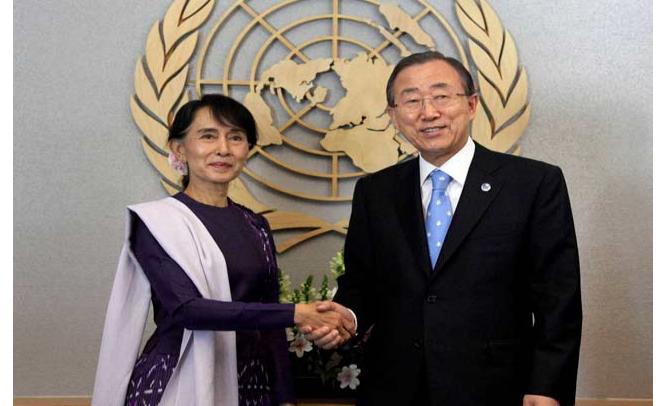Myanmar’s transition presents unparalleled challenges and possibilities. building new roads and developing infrastructure are just few of its challenges.
Can a nation once intentionally isolated from the world be rebuilt from the outside in? After decades of isolation, Myanmar has an extraordinary amount of work to do on every imaginable front. The country needs access to billions of dollars to bring modern irrigation systems to rural farmers, roads and electricity to remote communities, as well as technical and vocational training to prepare the country’s youth for the jobs of the future.
Last month, the Asian Development Bank (ADB) and World Bank resolved the issue of Myanmar’s outstanding arrears, which had stood in the way of full resumption of activities. An avalanche of debt forgiveness from other creditors followed, reducing the country’s foreign debt by 60%. All of this came on the heels of the government’s unveiling of an ambitious new blueprint for the country’s economic and social transformation.
The international community has made its support clear. However, Myanmar must proceed with caution: a rapid influx of foreign assistance and investment, however well-intentioned, can have a series of unintended and negative consequences if not well managed. If the cornerstones of success – stability, transparency, participation, capacity and accountability – are not firmly in place, the rich-poor divide will grow and corruption will thrive.
One thing we have learned over the last decades is that regional cooperation can have an important role to play in balancing competing interests looking to direct or define Myanmar’s re-emergence.
Despite the perception of Myanmar as a hermit kingdom, the country is a long-standing member of the Greater Mekong Subregion and will assume the role of Chair of the Association of Southeast Asian Nations (ASEAN) in 2014.
Deepening its participating in these regional bodies could help Myanmar to leapfrog by leveraging existing, mutually-beneficial plans for sub-regional projects like power grids or economic corridors. Myanmar’s per capita electricity consumption is among the lowest in Asia, with as few as one in four people having access to electric power, a figure that drops as low as only 16% in some rural areas. More active participation in regional groupings will also mean regional social programs around disaster relief, the prevention of human trafficking, and control of health epidemics can also be more effective.
Myanmar’s development is also of crucial importance to its neighbors as it provides the “missing link” connecting India, [People’s Republic of] China and Southeast Asia. Building these connections – roads, bridges, railways, etc. – will come with massive costs. Regional financial cooperation, in the form of the ASEAN+3 Asian Bond Markets Initiative and the Credit Guarantee and Investment Facility, can help meet Myanmar’s needs by effectively mobilizing public and private savings in Asia via equities, bonds, and insurance. Finding its place along the supply chains and production networks forged to build “Factory Asia” will also accelerate growth, productivity and employment generation not just in urban enclaves, but in more remote areas as well.
Some of Myanmar’s regional neighbors have wrestled with the challenges of rapid change, and offer important lessons. Cambodia and Lao People’s Democratic Republic (Lao PDR), for example, have seen the benefits of land bridges to Southeast Asia’s busier ports. They’re being supported to improve their competitiveness by reducing production costs and transport times, for benefits within their own borders and beyond. Both countries profit from regional migration and Lao PDR is exploring ways to gain from its abundant hydropower potential. It’s also luring unprecedented levels of foreign direct investment by leveraging its inclusion in the ASEAN Economic Community 2015.
Reforms in property law and FDI regulations (amongst other measures) have catapulted Viet Nam to middle income status, and put the country on a path to extending significant economic gains to rural communities and among ethnic minorities.
Myanmar’s challenge is to adapt “what worked” in other countries, but before the country can fully reap the benefits of stronger links with its neighbors, Myanmar must look within its own borders.
Building a business environment that is open yet predictable is key, and requires the establishment of regulations like property rights and the rule of law. The economy needs job opportunities for large swaths of the population, meaning the agriculture and manufacturing sectors must be strengthened. All of this must happen without overlooking environmental impact, and the critical importance of social stability.
Before turning on the tap of donor aid and FDI, Myanmar must have the tools needed to cope – the laws, policies and transparent enforcement mechanisms that will allow the country to improve its economy at a pace it can handle, without leaving it vulnerable to initiatives that exploit and exhaust resources in a manner that benefits only the few, not the many.
Its best chance at success is putting the ownership of its development resources agenda in the hands of its people, equipping them with the skills needed to seize the opportunities re-emergence will bring. This is a challenge recognized in the “Nay Pyi Taw Accord for Effective Development Cooperation” adopted by the country and the international donor community in January.
After decades of isolation, Myanmar’s greatest deficit is not just poor roads, scant power lines or under-developed telecommunication networks. It is the untapped potential of its people. Aggressively expanding quality education and training opportunities, in tandem with policy reforms that foster job creation, equality, and equitable business opportunity, will go a long way toward putting the country on the right track.
Myanmar’s transition presents unparalleled challenges and possibilities. By balancing the opportunities Myanmar possesses with the realities it faces, we can collectively help ensure that the country remains on the right road to prosperity.
Source:This article was first published by the Asian Development Bank (www.adb.org).


